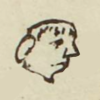Motolinia (MH788r)
This black-line drawing of the simplex glyph for the personal name, Motolinia (“He is Poor,” or "He is Afflicted," attested here as a man’s name). This person could also be named after a famous Franciscan friar. The glyph consists of the head of a bald man, shown in profile and looking down.
Stephanie Wood
Fray Toribio de Benavente Motolinia is likely the person after whom this Nahua man is named, but if not, then he is just being called a “Poor Person.” Possible supporting evidence that Nahuas took the name of the friar is that many men also took the name Toribio, and a few took other ecclesiastics’ names, such as “de Gante.” If the friar’s eye is closed in this glyph, it would suggest that he has passed away. But his biographies say he passed away in 1569, several years after the Matrícula de Huexotzinco was made.
Stephanie Wood
1560
Jeff Haskett-Wood
pobresa, humilde, nombres famosos, nombres de hombres

Motolinia, the name of a Franciscan missionary or a poor person, https://nahuatl.wired-humanities.org/content/motolinia
(una person pobre o el nombre de un fraile Franciscano)
Stephanie Wood
Matrícula de Huexotzinco, folio 788r, World Digital Library, https://www.loc.gov/resource/gdcwdl.wdl_15282/?sp=650&st=image
This manuscript is hosted by the Library of Congress and the World Digital Library; used here with the Creative Commons, “Attribution-NonCommercial-ShareAlike 3.0 License” (CC-BY-NC-SAq 3.0).










